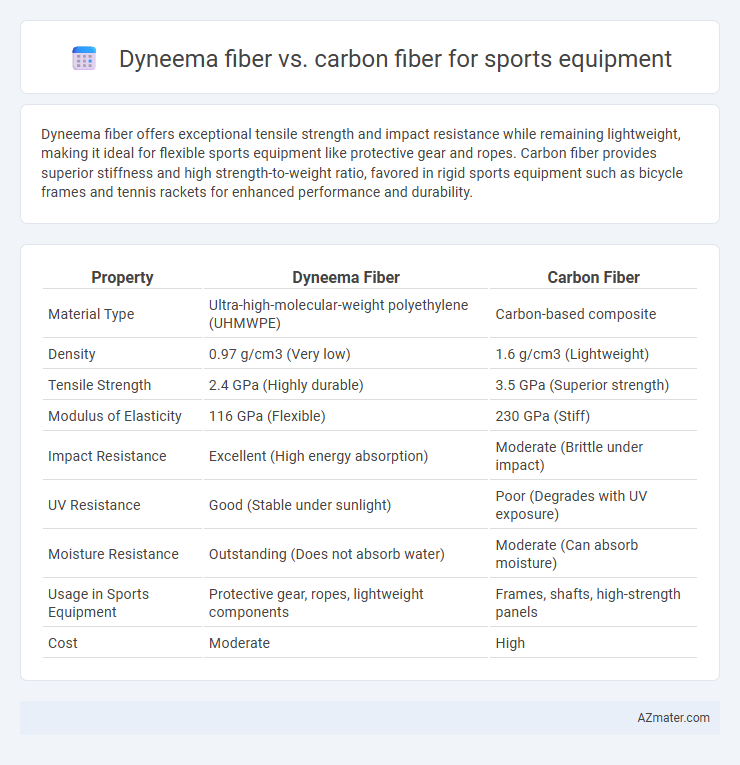Dyneema fiber offers exceptional tensile strength and impact resistance while remaining lightweight, making it ideal for flexible sports equipment like protective gear and ropes. Carbon fiber provides superior stiffness and high strength-to-weight ratio, favored in rigid sports equipment such as bicycle frames and tennis rackets for enhanced performance and durability.
Table of Comparison
| Property | Dyneema Fiber | Carbon Fiber |
|---|---|---|
| Material Type | Ultra-high-molecular-weight polyethylene (UHMWPE) | Carbon-based composite |
| Density | 0.97 g/cm3 (Very low) | 1.6 g/cm3 (Lightweight) |
| Tensile Strength | 2.4 GPa (Highly durable) | 3.5 GPa (Superior strength) |
| Modulus of Elasticity | 116 GPa (Flexible) | 230 GPa (Stiff) |
| Impact Resistance | Excellent (High energy absorption) | Moderate (Brittle under impact) |
| UV Resistance | Good (Stable under sunlight) | Poor (Degrades with UV exposure) |
| Moisture Resistance | Outstanding (Does not absorb water) | Moderate (Can absorb moisture) |
| Usage in Sports Equipment | Protective gear, ropes, lightweight components | Frames, shafts, high-strength panels |
| Cost | Moderate | High |
Introduction to Dyneema and Carbon Fiber
Dyneema fiber, known for its exceptional strength-to-weight ratio and high resistance to impact and abrasion, is widely used in sports equipment requiring durability and flexibility, such as protective gear and high-performance sails. Carbon fiber boasts superior stiffness, lightweight properties, and excellent fatigue resistance, making it ideal for sports equipment demanding rigidity and precision, including bicycle frames and tennis rackets. Both fibers revolutionize sports gear by enhancing performance through their distinct mechanical properties and weight advantages.
Material Composition and Properties
Dyneema fiber, composed of ultra-high-molecular-weight polyethylene (UHMWPE), offers exceptional tensile strength, low weight, and high impact resistance, making it ideal for flexible and lightweight sports equipment such as protective gear and racing sails. Carbon fiber consists of thin strands of carbon bonded together in a polymer matrix, delivering superior stiffness, high strength-to-weight ratio, and excellent fatigue resistance, which makes it preferred for rigid structures like bike frames and tennis rackets. While Dyneema excels in durability and flexibility under dynamic loads, carbon fiber outperforms in rigidity and structural integrity for precision sports applications.
Strength-to-Weight Ratio Comparison
Dyneema fiber exhibits an exceptional strength-to-weight ratio, being up to 15 times stronger than steel while remaining ultra-light, making it ideal for flexible sports equipment like ropes and protective gear. Carbon fiber also offers a high strength-to-weight ratio with superior stiffness and rigidity, often favored in performance-driven applications such as bicycle frames, tennis racquets, and golf clubs. In terms of impact resistance, Dyneema outperforms carbon fiber by absorbing energy through its molecular structure, whereas carbon fiber tends to be more brittle despite its lightweight strength.
Flexibility and Impact Resistance
Dyneema fiber offers superior flexibility compared to carbon fiber, allowing sports equipment to absorb and distribute impact forces more effectively without compromising movement. Carbon fiber excels in stiffness and strength but is more brittle, making it less able to withstand high-impact forces without cracking. For applications requiring a balance of lightweight durability and impact resistance, Dyneema fiber is often preferred in protective gear, while carbon fiber suits rigid performance components like bike frames.
Durability and Longevity
Dyneema fiber exhibits exceptional durability, offering high resistance to abrasion, impact, and fatigue, which extends the longevity of sports equipment under harsh conditions. Carbon fiber, while lightweight and strong, can be prone to brittleness and micro-cracking over time, potentially reducing its lifespan when subjected to repeated stress. Sports gear utilizing Dyneema fiber often benefits from superior toughness and longer service life, making it ideal for applications demanding sustained durability.
Performance in Sports Applications
Dyneema fiber offers exceptional tensile strength and impact resistance, making it ideal for sports equipment requiring lightweight durability, such as protective gear and high-performance sails. Carbon fiber provides superior stiffness and rigidity, enhancing responsiveness and power transfer in applications like bicycle frames and tennis rackets. Both fibers excel in sports, with Dyneema favored for flexibility and energy absorption, while carbon fiber dominates in stiffness and precision performance.
Weight Reduction and Athlete Advantage
Dyneema fiber offers exceptional weight reduction due to its high strength-to-weight ratio, making sports equipment lighter and more durable without sacrificing performance. Carbon fiber, while also lightweight, provides superior stiffness and rigidity that enhances equipment responsiveness and control during high-intensity activities. Athletes benefit from Dyneema's impact resistance and flexibility, which reduce fatigue and improve comfort, whereas carbon fiber delivers precise energy transfer for explosive power and speed.
Cost and Accessibility
Dyneema fiber offers a cost-effective alternative to carbon fiber for sports equipment, providing high strength-to-weight ratios at a lower price point due to its polymer-based composition. Carbon fiber, while more expensive because of its complex manufacturing process and premium material properties, delivers superior stiffness and durability preferred in high-performance gear. Accessibility to Dyneema is more widespread because of easier production and lower raw material costs, whereas carbon fiber products remain limited to specialized suppliers and high-end markets.
Environmental Impact and Sustainability
Dyneema fiber offers a lower carbon footprint compared to carbon fiber due to its bio-based raw materials and energy-efficient production processes, promoting sustainability in sports equipment manufacturing. Carbon fiber, while known for its strength and lightweight properties, involves high energy consumption and generates significant waste during production, posing environmental challenges. Choosing Dyneema enhances eco-friendly sports gear by reducing greenhouse gas emissions and supporting circular economy practices through recyclability.
Future Trends in Sports Equipment Materials
Dyneema fiber and carbon fiber represent two leading materials driving innovation in sports equipment, with Dyneema offering exceptional tensile strength and lightweight flexibility, making it ideal for protective gear and high-performance textiles. Carbon fiber remains dominant in applications requiring superior stiffness and low weight, such as bicycle frames and racquets, due to its unmatched rigidity and vibration damping properties. Future trends emphasize hybrid composites combining Dyneema's impact resistance with carbon fiber's structural integrity, enabling next-generation sports gear that enhances athlete safety and performance through advanced material science and sustainable manufacturing processes.

Infographic: Dyneema fiber vs Carbon fiber for Sports equipment
 azmater.com
azmater.com